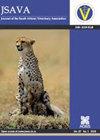Use of etorphine hydrochloride for immobilisation of Nubian giraffe for wire snare removal: a retrospective study
IF 0.9
4区 农林科学
Q3 VETERINARY SCIENCES
引用次数: 0
Abstract
high incidence of reported complications, including mortality during giraffe immobilisations, there is a need for developing and refining techniques and sharing information to facilitate widespread application. This retrospective study utilised immobilisation data acquired during wire snare removals from 80 Nubian giraffe induced with intramuscular etorphine hydrochloride. Recorded data included age (adult, subadult), sex, estimated weight, body condition score, induction and reversal drug dosage, induction time, quality of induction, duration of the procedure, time to reversal administration, and snare wound characteristics. There were no statistically significant differences between males and females for induction quality ( p > 0.99), induction time ( p = 0.72), and procedure time ( p = 0.18). No significant differences were noted between adults and subadults for induction quality ( p = 0.16) and procedure time ( p = 0.35). There was a significant difference in induction time between adults (7.58 ± 0.42 minutes) and subadults (5.65 ± 0.56 minutes) ( p < 0.01). On average, adults received 12.4 mg etorphine while subadults received 11.6 mg. Wound severity did not have a significant impact on induction quality. No mortality was observed. Based on these data, etorphine hydrochloride, followed by rapid reversal, was safe for induction of Nubian giraffe presenting for snare removal and should be considered in similar circumstances.使用盐酸艾托啡固定努比亚长颈鹿钢丝圈套去除:回顾性研究
本文章由计算机程序翻译,如有差异,请以英文原文为准。
求助全文
约1分钟内获得全文
求助全文
来源期刊

Journal of the South African Veterinary Association
VETERINARY SCIENCES-
CiteScore
1.50
自引率
0.00%
发文量
23
审稿时长
22 weeks
期刊介绍:
The Journal of the South African Veterinary Association is a contemporary multi-disciplinary scientific mouthpiece for Veterinary Science in South Africa and abroad. It provides veterinarians in South Africa and elsewhere in the world with current scientific information across the full spectrum of veterinary science. Its content therefore includes reviews on various topics, clinical and non-clinical articles, research articles and short communications as well as case reports and letters.
 求助内容:
求助内容: 应助结果提醒方式:
应助结果提醒方式:


